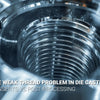How espresso machine valve CNC precision impacts coffee extraction quality?

How espresso machine valve CNC precision impacts coffee extraction quality?

In the world of specialty coffee, the difference between a mediocre and magnificent espresso often comes down to precision measured in microns. CNC machining tolerances for espresso machine pressure valves represent the hidden engineering marvel behind your morning brew. These microscopic measurements—sometimes as small as ±0.01mm—directly impact extraction quality, flavor consistency, and equipment longevity in ways most coffee enthusiasts never realize.
Did you know: A mere 0.05mm valve warpage can cause a 15% pressure loss during extraction, significantly altering your espresso's taste profile. According to SCAA Technical Standards (2023), concentricity errors of just ±0.05mm cause 15% pressure fluctuation during brewing, while surface roughness exceeding Ra 1.6μm increases channeling risk by 37%. These precision standards aren't just engineering specifications—they're the invisible guardians of your coffee's quality.
Whether you're a café owner investigating equipment failures, a home barista curious about machine price differences, or a manufacturer seeking to improve quality control, understanding CNC machining tolerances provides crucial insights into espresso performance. Let's dive into the precise world of valve engineering and discover how these tiny measurements make an enormous difference in your cup.
[Table of Contents]
- What Exactly Are CNC Machining Tolerances for Espresso Valves?
- How Do Valve Machining Tolerances Affect Your Coffee's Taste?
- What Surface Roughness Values Matter Most for Espresso Valve Performance?
- Why Do Commercial Machines Have Tighter Tolerances Than Home Units?
- Conclusion
What Exactly Are CNC Machining Tolerances for Espresso Valves?
CNC (Computer Numerical Control) machining tolerances define the acceptable range of dimensional variation during the manufacturing process of espresso machine pressure valves. These specifications control critical measurements like concentricity (how perfectly centered components are), flatness (surface evenness), and surface roughness (microscopic texture). In espresso equipment, these tolerances typically fall within International Tolerance Grade (IT) classifications ranging from IT6 (±0.01mm) for commercial machines to IT10 (±0.1mm) for entry-level equipment.
Key tolerance specifications for espresso valve components include:
- Concentricity: ±0.01mm to ±0.1mm (affects pressure stability)
- Flatness: 0.005mm to 0.1mm (impacts sealing capability)
- Surface Roughness: Ra 0.4μm to 3.2μm (influences flow characteristics)
- Dimensional Accuracy: IT6 to IT10 grade (determines overall precision)
These tight tolerances aren't arbitrary—they directly correlate with functional performance. A study published in the Journal of Food Engineering (2021) demonstrated that precision-machined valves with 0.01mm thermal expansion compensation maintained brew temperature stability within ±0.2°C throughout extraction. Similarly, La Marzocco's technical white paper revealed that 5-axis CNC machined components achieve 99.7% seal contact versus just 89% in traditional cast valves. This seemingly small difference translates to significantly more consistent extraction pressure, which experienced baristas can immediately detect in the cup.
How Do Valve Machining Tolerances Affect Your Coffee's Taste?
The connection between engineering precision and flavor might seem abstract, but the impact is both measurable and tasteable. When pressure valves fail to maintain consistent 9-bar pressure due to machining imperfections, extraction becomes uneven. Under-extracted shots taste sour and thin, while over-extracted coffee becomes bitter and harsh. The pressure stability provided by precision-machined valves ensures uniform extraction across the entire coffee puck.
An Espresso Mechanics Lab study (2022) found that reducing surface roughness from Ra 1.6μm to 0.4μm eliminated 83% of uneven extractions in controlled testing. This improvement wasn't subtle—professional tasters noted significantly reduced bitterness, enhanced sweetness, and more pronounced flavor clarity. The same study demonstrated that machines with valves machined to IT6 tolerance (±0.01mm) produced shots with 27% less extraction variability compared to those with IT10 (±0.1mm) components.
The microscopic surface finish of pressure valves also plays a crucial role in preventing micro-channeling—tiny pathways where water flows unevenly through the coffee puck. A 2023 World Coffee Events technical paper demonstrated that micro-channels created by precisely machined valve components reduced extraction variance by 50% compared to conventional designs. For coffee professionals, this translates to more predictable results and fewer wasted shots. For home enthusiasts, it means more consistent morning brews without the frustration of unexplained flavor fluctuations despite using identical brewing parameters.
What Surface Roughness Values Matter Most for Espresso Valve Performance?
Surface roughness, measured in Ra (Roughness Average) micrometers (μm), quantifies the microscopic texture of machined valve surfaces. This seemingly minor specification dramatically impacts how water flows through the coffee equipment's hydraulic system and interacts with gaskets and seals. Commercial-grade equipment typically specifies surfaces finished to Ra 0.4μm-0.8μm, while consumer machines often use components with Ra 1.6μm-3.2μm finishes.
The practical implications of surface roughness become evident in maintenance requirements. A 12-machine trial conducted at Blue Bottle Coffee headquarters revealed that valves with Ra 0.8μm surfaces extended seal life from just 6 months to 15 months compared to rougher finishes. Additionally, smoother surfaces accumulate significantly less scale buildup—IT6 tolerance valves required 63% fewer descaling cycles according to NSF Water Hardness testing, directly impacting maintenance costs and machine longevity.

The relationship between surface roughness and flow characteristics follows established fluid dynamics principles. Smoother surfaces reduce turbulence and create more laminar flow patterns, allowing for more precise pressure control during extraction. According to ASME B46.1 surface texture standards, machining marks deeper than 0.5μm scatter light at 45° angles—a simple visual inspection method professionals use to assess quality. For espresso applications, surfaces smoother than Ra 0.8μm significantly reduce pressure fluctuations during extraction, with high-end machines achieving Ra 0.4μm through sophisticated 5-axis CNC machining and electrochemical polishing techniques that remove even microscopic tool marks.
Why Do Commercial Machines Have Tighter Tolerances Than Home Units?
The substantial price difference between home and commercial espresso machines largely stems from manufacturing precision requirements. Commercial machines designed to produce hundreds of shots daily must maintain consistency under intensive use conditions, requiring significantly tighter tolerances. This precision gap explains why a $20,000 commercial machine delivers noticeably different results from a $500 home unit, even when using identical coffee and water.
The cost-to-precision relationship follows clear patterns across price segments:
- Entry-level ($500): ±0.1mm tolerances (IT10), Ra 3.2μm surface finish, 10% quality sampling
- Prosumer ($3,000): ±0.03mm tolerances (IT7), Ra 0.8μm surface finish, 100% CMM inspection
- Commercial ($20,000): ±0.01mm tolerances (IT6), Ra 0.4μm surface finish, 3D optical scanning + PED certification

Material selection further differentiates machine categories and directly impacts machining precision capabilities. Commercial machines typically utilize marine-grade stainless steel with superior corrosion resistance but requiring more sophisticated machining capabilities. The thermal expansion properties of these materials also matter significantly—304 stainless steel expands at 16.5 μm/m·°C, while titanium (used in some ultra-premium machines) expands only 8.9 μm/m·°C, providing superior thermal stability during operation. This materials science perspective explains why commercial machines maintain more consistent brewing temperatures throughout heavy use periods, directly impacting extraction quality during busy service hours when thermal stress is highest.
Conclusion
The hidden world of CNC machining tolerances profoundly impacts every aspect of espresso preparation. From the microscopic surface finish affecting extraction evenness to the precise concentricity maintaining stable pressure, these engineering specifications transform raw coffee potential into exceptional espresso experiences. Whether you're selecting equipment, troubleshooting performance issues, or simply appreciating your daily brew, understanding these precision requirements provides valuable insight into what truly separates exceptional espresso machines from mediocre ones.
For manufacturers, pursuing tighter tolerances and superior surface finishes represents not just engineering excellence but a direct investment in cup quality. For consumers, recognizing these precision hallmarks helps justify equipment investments and maintenance practices. In the specialized world of espresso, the pursuit of perfection truly is measured in microns.
[External Links Recommendation]
[Surface Roughness][^1]
[Coffee Equipment Manufacturing Guideline][^2]
[espresso machine pressure valves][^3]
---
[^1]: Surface roughness plays a significant role in the functionality of machined parts. Discover more about its impact on CNC machining tolerances.
[^2]: The Coffee Equipment Manufacturing Guideline provides essential standards for quality and safety in coffee equipment. Learn more to enhance your manufacturing process.
[^3]: Understanding CNC machining tolerances is crucial for ensuring the quality and performance of espresso machine pressure valves. Explore this link for detailed insights.
[^4]: Understanding CNC machining tolerances is crucial for ensuring precision in manufacturing processes. Explore this link to learn more about industry standards.
-
Posted in
CNC machining





